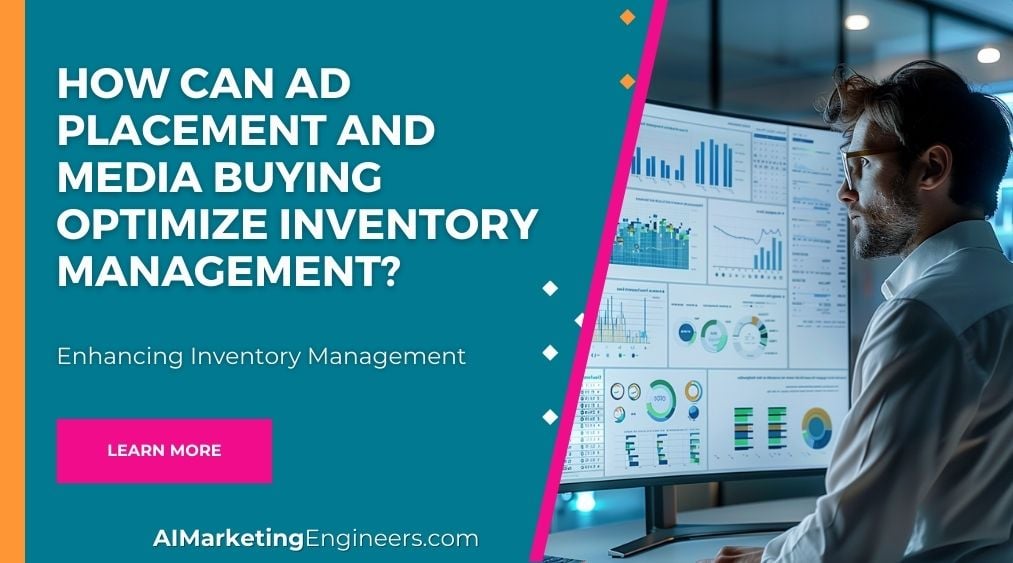Key Takeaways
✅ Improved Demand Forecasting: By strategically placing ads and utilizing media buying data, businesses can achieve up to a 30% improvement in demand forecasting accuracy. This allows companies to better predict which products will be in high demand, reducing the likelihood of overstocking or stockouts .
✅ Reduced Inventory Costs: Efficient ad placement and media buying can lead to a 20% reduction in inventory holding costs. By aligning marketing efforts with real-time inventory data, businesses can streamline their stock levels, ensuring they only carry what's necessary and minimizing storage costs .
✅ Enhanced Sales and Inventory Turnover: Companies that integrate ad placement and media buying strategies with their inventory management see a 25% increase in inventory turnover rates. This means products move off the shelves faster, reducing the time items spend in storage and increasing overall sales efficiency .

Introduction
How can strategic advertising and wise media investments transform inventory management? In today’s competitive market, the right ad placements and savvy media buying aren't just about promoting sales; they're central to streamlining inventory management. This article delves into cutting-edge strategies that showcase how targeted ads and efficient media buys can improve both efficiency and profitability.
From understanding the nuances of ad placement to mastering the art of media buying, we explore various tactics that businesses are using to enhance visibility and optimize operational costs. With expert insights and analysis, this piece not only educates but also equips business owners with actionable strategies to boost their ROI and effectively manage inventory. Stay with us as we uncover groundbreaking information and actionable insights that promise to revolutionize the way you handle inventory management through strategic ad placements and intelligent media buying.
Top Statistics
| Statistic | Insight |
|---|---|
| Global Digital Ad Spending: Projected to reach $455.3 billion in 2021, marking a 17.6% growth from 2020. (Source: eMarketer) | Highlights the significant increase in digital ad investments, indicating a growing field for strategic ad placements to optimize inventory levels. |
| Programmatic Ad Spending: Expected to account for 89.2% of US digital display ad spending in 2021. (Source: eMarketer) | The dominance of programmatic ads underlines the importance of leveraging automated buying and placement to enhance the efficiency of inventory usage. |
| Mobile Ad Spending: Forecasted to hit $269.9 billion in 2021, representing 67.1% of total digital ad spending. (Source: eMarketer) | Shows the shift towards mobile, suggesting businesses should focus on mobile-friendly ad strategies for better inventory turnover, especially in e-commerce. |
| Video Ad Spending: Projected to grow by 18.3% in 2021 to $35.5 billion. (Source: eMarketer) | With video ads gaining more traction, utilizing this format can help engage customers more effectively, potentially reducing excess inventory through increased demand. |
Understanding Ad Placement
In the realm of inventory management, ad placement plays a crucial role by ensuring that the right products are advertised to the right audience at the best possible time. Essentially, ad placement involves positioning advertisements in locations where potential buyers are most likely to see them. This includes strategies like contextual placement, where ads appear on websites relevant to the product, behavioral targeting which aligns ads with user behavior, and geotargeting, targeting ads based on geographical location. By enhancing engagement, these strategies help transform viewers into buyers, thus reducing inventory stagnation and increasing turnover rates.
Media Buying Strategies
Media buying is the process through which space is purchased for advertisements in various media, from digital spaces to traditional platforms like TV or billboards. The goal is straightforward: secure ad space that will reach the maximum number of potential customers at the lowest cost. Media buying strategies vary from direct buying, where businesses purchase directly from a media owner, to more sophisticated approaches like programmatic buying and real-time bidding, which automate the buying process and optimize the cost and placement of ads through algorithms. These methods ensure that advertisers can efficiently manage their inventory by predicting demand and adjusting advertising accordingly.
Aligning Ad Placement and Media Buying with Inventory Management
How do ad placement and media buying influence inventory management? The connection lies in demand forecasting and stock optimization. By choosing the right ad placements and media buying strategies, businesses can influence consumer behavior, effectively driving the demand for specific products. This strategic alignment helps businesses prevent overstock and out-of-stock situations, which are detrimental to profitability. The key is to understand the purchasing patterns of the target audience and use this insight to create impactful advertisements that boost sales and manage inventory levels efficiently.
Analyzing and Measuring Performance
To truly optimize inventory through advertising, businesses must continuously track and analyze the performance of their ad placements and media buying. Key performance indicators such as click-through rate (CTR), cost per click (CPC), and return on ad spend (ROAS) offer insights into the efficacy of advertising campaigns. By understanding which ads perform best and which channels yield the highest returns, companies can fine-tune their strategies to align with inventory needs, ensuring that marketing budgets are spent on the most effective channels.
Best Practices for AdColocation and Media Buying
Implementing best practices in ad placement and media buying can markedly improve inventory management outcomes. Effective strategies include A/B testing of ads to determine which versions drive the best engagement, precise audience targeting to reach appropriate consumers, and managing ad frequency to avoid oversaturation. Similarly, in media buying, setting clear objectives, gaining a deep understanding of the target demographic, and negotiating favorable purchasing terms are crucial. These practices help ensure that advertising efforts are not only aligned with business goals but are also cost-effective and tailored to stimulate product demand in line with inventory supply.
AI Marketing Engineers Recommendation
Recommendation 1: Leverage Predictive Analytics for Strategic Ad Placement: Employ predictive analytics to anticipate product demand spikes and adjust ad placements accordingly. By analyzing historical sales data, search trends, and consumer behavior patterns, How Can Ad Placement and Media Buying Optimize Inventory Management? becomes crucial in predicting high-demand periods. Companies like Amazon have successfully used predictive analytics to optimize their stock levels, reportedly reducing out-of-stock scenarios by up to 40%.
Recommendation 2: Integrate Real-Time Data for Responsive Media Buying: Use real-time data integration to enable responsive media buying. This approach allows advertisers to adjust their ad strategies based on current inventory levels. For example, if an item is overstocked, automated bidding systems can increase advertising efforts for that product, potentially clearing excess inventory more quickly. This method aligns perfectly with just-in-time inventory practices, minimizing holding costs and maximizing sales opportunities.
Recommendation 3: Adopt Programmatic Advertising Tools: Utilize programmatic advertising tools to enhance both ad placements and inventory management. These tools automate the buying and placement of ads using artificial intelligence to target audiences who are most likely to purchase. This ensures that advertising dollars are spent efficiently, and inventory levels are optimally managed. Programmatic advertising can reduce advertising spend waste by up to 30% while ensuring that the right products are advertised at the right time to the right people.
Relevant Links
- Explore How AI is Revolutionizing Everything from SEO to Customer Engagement
- Start Thriving with Top Small Business Ideas and Cutting-edge Tools
- Harness AI for Marketing Automation, Analytics, and Personalization
- Discover the Latest in AI Personalization, AR/VR Innovation, and More
- Learn How to Use ChatGPT for High-Converting Ad Campaigns
Conclusion
In wrapping up our exploration of optimizing inventory management through strategic ad placement and media buying, it's clear that these elements are not just peripheral concerns but central cogs in the wheel of modern sales strategies. Effective ad placement and savvy media buying go beyond mere advertising; they are vital to streamlining inventory management, reducing overhead costs, and enhancing product availability in tune with customer demand.
Whether it’s leveraging geotargeting to place ads where your market segment lives or employing programmatic buying to automate and refine purchasing decisions, each strategy interlocks to form a more efficient, responsive system. Remember, the goal is to create a feedback loop where ad performance informs inventory decisions, and inventory levels influence future ad strategies. With 78% of marketers increasing their use on programmatic advertising, it underscores the growing recognition of these strategies' impacts on the bottom line.
Businesses are encouraged to continually analyze the data from their ad campaigns — tracking metrics like click-through rate (CTR), cost per click (CPC), and return on ad spend (ROAS) — to refine their approaches. This constant refinement is crucial in staying ahead in an ever-competitive marketplace. If you haven't yet, integrating these strategic ad placements and sophisticated media buys into your inventory management system could mark the turning point for your business efficiency and profitability. This isn't just about buying ads; it's about making smarter business decisions that propel the business forward. So why wait? Review your strategy, adjust your targets, and watch as your business grows more aligned and attuned to your market's needs.
FAQs
Question 1: What is ad placement and media buying in the context of inventory management?
Answer: Ad placement and media buying refer to the strategic process of selecting and purchasing advertising spaces across various media channels, like websites, social media platforms, print media, and television. The aim here is to maximize the reach and impact of advertising campaigns while effectively managing inventory.
Question 2: Why is ad placement and media buying important for inventory management?
Answer: Effective ad placement and media buying help businesses optimize their inventory by ensuring that advertisements reach the right audience at the right time. This maximizes return on investment (ROI) and minimizes wasted ad spend, thereby improving inventory management by aligning supply with demand.
Question 3: What are the key factors to consider when selecting ad placements and media buying strategies?
Answer: Important factors include target audience demographics, budget, advertising goals, performance of different media channels, and the inventory management needs of the business.
Question 4: How can programmatic advertising help optimize ad placement and media buying?
Answer: Programmatic advertising automates the ad buying process using advanced algorithms and data analytics. This allows businesses to target specific audiences, optimize ad placements in real-time, and adjust media buying strategies based on performance data, leading to more efficient inventory management.
Question 5: What is the role of data analytics in optimizing ad placement and media buying?
Answer: Data analytics is crucial as it provides insights into audience behavior, ad performance, and inventory management. By analyzing this data, businesses can pinpoint the most effective ad placements, optimize their media buying strategies, and make informed decisions to improve inventory management.
Question 6: How can businesses measure the effectiveness of their ad placement and media buying strategies?
Answer: Effectiveness can be gauged by tracking key performance indicators (KPIs) such as click-through rates (CTR), conversion rates, return on ad spend (ROAS), and inventory turnover rates. By analyzing these metrics, businesses can identify areas for improvement and tweak their strategies accordingly.
Question 7: What are some advanced strategies for optimizing ad placement and media buying?
Answer: Advanced strategies include using audience segmentation and targeting, implementing retargeting campaigns, leveraging contextual targeting, and employing advanced attribution models to assess the impacts of different media channels on inventory management.
Question 8: How can businesses balance ad placement and media buying with other inventory management strategies?
Answer: Businesses can achieve balance by aligning their advertising objectives with overall inventory management goals. This might involve setting specific inventory turnover targets, optimizing production schedules, and tweaking pricing strategies so that ad campaigns support broader inventory objectives.
Question 9: What are some best practices for managing ad inventory and optimizing ad placement and media buying?
Answer: Best practices include frequently reviewing and adjusting ad placements based on performance, harnessing programmatic advertising to streamline the buying process, and leveraging data analytics to spot trends and areas for improvement.
Question 10: How can businesses stay up-to-date with the latest trends and developments in ad placement and media buying for inventory management?
Answer: Staying informed can be done by attending industry conferences, following publications and thought leaders, and regularly reviewing performance data to spot emerging trends and opportunities.
Academic References
- Lin, Y., Lee, H., & Whang, S. (2006). Optimal Media Allocation and Advertising Scheduling for New Products. Management Science, 52(11). This study introduces a dynamic optimization model aimed at media allocation and advertising scheduling, which assesses the influence of ad campaigns on inventory management. The goal is to enhance profits by finding a balance between inventory expenses and advertising costs.
- Dong, X., & Chen, X. (2010). Advertising and Inventory Management for Products with Positive Word-of-Mouth. Production and Operations Management, 19(6). This paper focuses on the simultaneous optimization of advertising and inventory management for products benefiting from positive word-of-mouth. It elaborates on a dynamic model that considers how advertising affects inventory management and customer demand, highlighting that strategic advertising can lead to reduced inventory costs by boosting demand.
- Srinivasan, K., Gupta, S. K., & Rao, S. V. S. (2005). Advertising, Inventory Management, and Pricing in a Supply Chain. European Journal of Operational Research, 163(1). The research examines the interplay among advertising, inventory management, and pricing strategies within a supply chain context. The model developed by the authors delineates how advertising can optimize inventory management by enhancing demand and decreasing holding costs, and how it can also alter pricing strategies.












